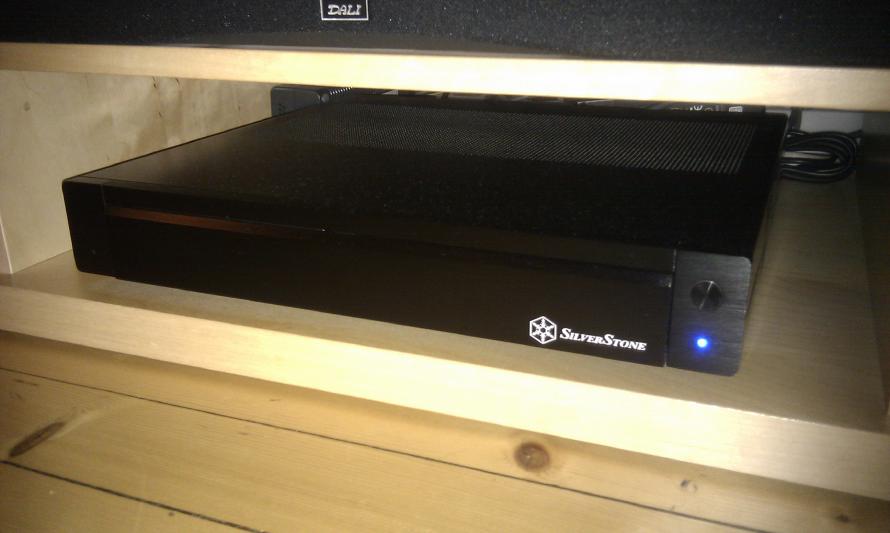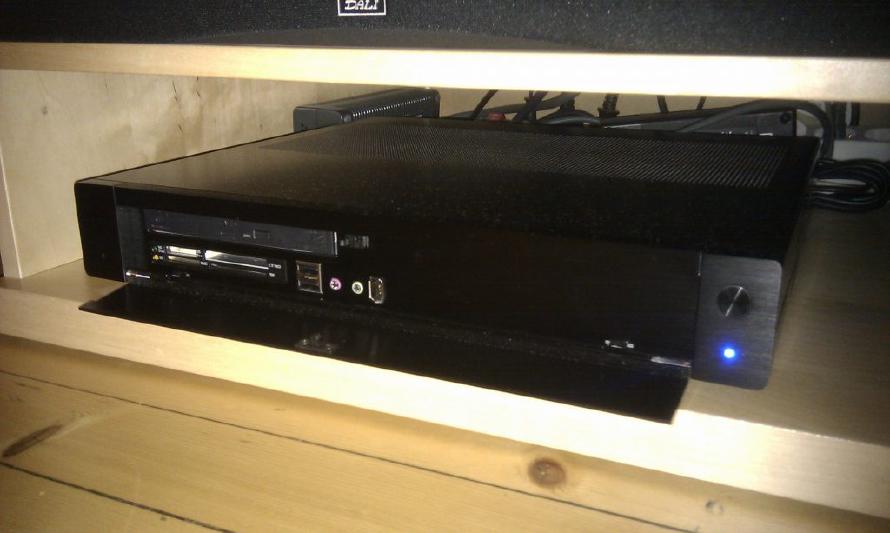How To Build a Silent Mini-ITX server
Please note that this post was written back in 2010. I’ve since built a new Mini-ITX server, and this time it’s even smaller and actually totally silent. Read all about it in the post “How To Build a Teeny Tiny and Totally Silent Mini-ITX Server”.
After I moved this site to my own, home grown Mini-ITX server, I realized that I needed a new one. The current server didn’t have the horsepower to cope with the odd request peaks I was seeing and with only half of the 1GB of available RAM being recognized by the motherboard, I had a major problem. Even though the VIA CPU featured passive cooling, the chassis fan made a lot of noise and while disabling the fan didn’t make the server too hot, it just unveiled the fact that the hard drives were quite noisy as well.
So I set off on a quest to find the ultimate Mini-ITX for a home server for my web server and mail server. The server had to be both powerful and silent, meaning no noisy power supply, no CPU fans and no clicking hard drives. The only real way to achieve this is by building a server with no moving parts at all. I also wanted to use a enclosure that looked nice enough to have in the living room. After a lot of research I ended up with the following hardware:
- SilverStone Mini-ITX SST-LC19R black.
- Corsair 4GB DDR2 XMS2 PC6400 800MHz.
- Samsung DVD±R/RW/RAM slim DL 8X SATA black.
- ZOTAC ION ITX F series motherboard. This motherboard has since been replaced by an ASUS AT5IONT-I.
- Two Kingston V Drive notebook 64GB SSD SATA/300.
If you decide to build a server with the same hardware as me, there are a few things your should be aware of when it comes to the ZOTAC ION ITX F motherboard, SilverStone LC19R case, Kingston V SSD hard drives and Samsung slim SATA DVD drive:
- The Serial ATA (SATA) cables that come with the ZOTAC motherboard are all angled. This means that you will not be able to use them unless you either attach your hard drives upside down (not possible with the Kingston V SSD hard drives) or get rising brackets or something similar. You have to buy new SATA cables that are not angled.
- The screws provided with the ZOTAC motherboard are too large to attach the Kingston V SSD hard drives. There are no screws provided with the hard drives, so you have to get some smaller screws yourself.
- The USB cable for the internal card reader in the SilverStone case is too short and you will not be able to attach it to the ZOTAC motherboard. This means that you either have to buy an extension cable or consider buying the SilverStone LC19 instead, which comes without an internal card reader. I will not use the card reader in my box, so this is not a loss for me. The reason why I bought the LC19R was that the LC19 was unavailable.
- The SilverStone case comes with front connectors for IEEE 1394 FireWire, audio in and audio out. This is great, but there are no internal connectors on the ZOTAC motherboard for any of these, meaning that they cannot be used.
- That said, you will be able to use the two front panel USB connectors as that cable is long enough to reach the ZOTAC motherboard and it even has 2 internal connectors for USB (only 1 used used for the front panel USB connectors).
- No cables are provided for the Samsung slim SATA DVD drive. You have to buy a cable that fits to a slim SATA power and data connector, which, for some reason is not the same connectors used for SATA hard drives.
- You should also remember to buy a network cable. Even if the ZOTAC motherboard comes with an internal wireless LAN card, I will be using a good old network cable to connect to a network switch in my apartment. Because of this I don’t know if the wireless LAN card works or not in Ubuntu 9.10. This probably won’t be a problem if you’re using Windows, though.
- The ZOTAC motherboard comes with an Intel Atom 330 CPU with passive cooling. You should be aware of the fact that the CPU will overheat when the motherboard is inside the SilverStone case, even when the CPU is idling. This was a major disappointment for me, since the CPU had to be cooled down with a fan. To top it off, the CPU fan provided with ZOTAC motherboard is too large to fit in the SilverStone case. Thankfully you can move the case exhaust fan and attach it to the case by the CPU heat sink instead. This solved the overheating problem. If you want to use another fan, note that you can only fit 50x50mm fans inside the SilverStone LC19R case. A 3-pin connector is required to attach the fan connector to the ZOTAC motherboard.
- Since you are pretty much screwed if the CPU fan breaks down, it’s highly recommended that you buy a spare 50x50mm fan with a 3-pin connector just in case.
As you can see, there are quite a few gotchas when it comes to the hardware. I could probably have done a lot better research before I placed the hardware order, but it was hard to find information like this online. Even though none of the gotchas are critical, it’s rather annoying that most of the SilverStone LC19 front panel connectors can’t be used with the ZOTAC motherboard and that the Atom CPU didn’t stay cool enough with just passive cooling. When everything that can be attached and connected are actually attached and connected, the SilverStone case looks quite nice in my Hi-Fi rack.
So this is the reason why there hasn’t been any new entries this week, my spare time has been used to build the server and set up the necessary software. With a little luck, the server will be up and running tomorrow evening.
Update: As requested in the comments, here are some pictures of the box.


Feedback
Do you have any thoughts you want to share? A question, maybe? Or is something in this post just plainly wrong? Then please send an e-mail to vegard at vegard dot net with your input. You can also use any of the other points of contact listed on the About page.
Hi!
I am considering to build the same HTPC. Can the power that comes with LC19 be used to power the ZOTAC board or is it better to buy a Zotac that comes with a power supply?
by the way - Do you have any pictures of your HTPC?
best regards Finn
Hi Finn. I’ve added two pictures of the box to this post.
In my experience, the LC19R power supply is sufficient enough to handle the ZOTAC board. The power supply will provide up to 120W - I’m not sure how much power the board requires when running every chip at full capacity, but the LC19R enclosure is supposed to handle ATX motherboards, so I’m sure it has no problems with the ZOTAC Mini-ITX board.
What I would consider, however, is another board than the ZOTAC ION ITX F board. The reasons are mentioned in the entry: You will not be able to connect the front panel card reader (the LC19R’s cable is too short) or the front panel FireWire and audio in/out connectors - there are no internal connectors for FireWire and audio in/out on the board.
Also, I’m not using the Mini-ITX box as an HTPC box, but rather a web server, so I can’t say how well it works as a HTPC setup.
That said, good luck with your Mini-ITX box!
Hi
I’m thinking of buying this case but I already have a zotac ionitx-f-e so I would like to use this motherboard instead of buying another one. The only thing that matters is that the front USB ports are working… But I have a question regarding the CPU heat, how was it when you were using the case fan? Any problems with the heat or was the systel running smooth with just one fan?
I’ve got no problems with heat using the chassis fan only, but I’ve not used the board for any heavy video stuff, for instance.
Hi
I am considering to build the same HTPC case. But i do not like te card reader.
Can this card reader module be replaced with a aditional harddisk?
Removing the card reader should probably make room for a 2.5" hard drive, but you’’ll have to mount it below the CD drive stand. This stand is removable, however, so that should work out all right. Depending on the size of your motherboard, you can place a lot of disks in the case: I use a Mini-ITX form factor board, and have "mounted" two SSD disks with duplex tape to the left of the motherboard. Plenty of room, in other words.
How much power from the wall does it pull? Use something like kill-A-watt for a reading, at least that’s what I use.
I have no idea how much power it pulls from the wall, and I’m guessing it depends on the server load. The specifications from SilverStone (link removed because of malware warning, please search the internet instead) has some information about the power supply, if that helps.
Just curious, I like to compare and contrast how efficient CPUs are from generation to generation and PSUs as well. You find out real quick how efficient your brand of PSU is. Some PSUs are not very efficient and cost a lot. I think you want to between 60-70 % of your PSU at the wall to get the most stable and efficient out of your PSU, they tend to last longer as well. You 8W Atom probably not drawing a lot of power, I bet your no more then 40 W 50W at the most.
You would be surprise with all peripherals, any additional power demands on motherboard, and the efficiency of your PSU, that you don’t come any where close to TDP of your CPU. Of course your not always at load so with Intel energy states, your always using less power then the max TDP. Probably wouldn’t be cost effective to upgrade but new Bay Trail have a lot promise.
Power usage is always a factor I consider when buying hardware, but as you pointed out, it wouldn’t be cost effective to replace my current hardware just because an option with lower usage is available.